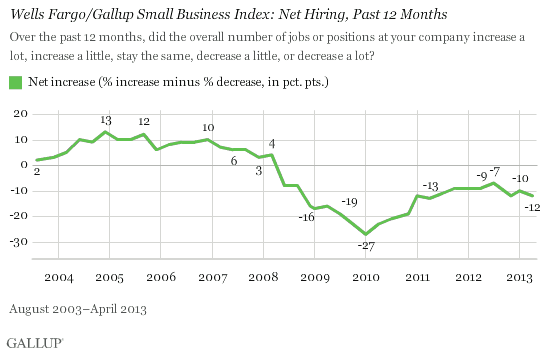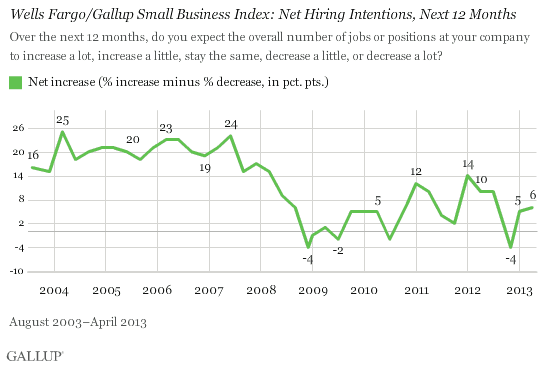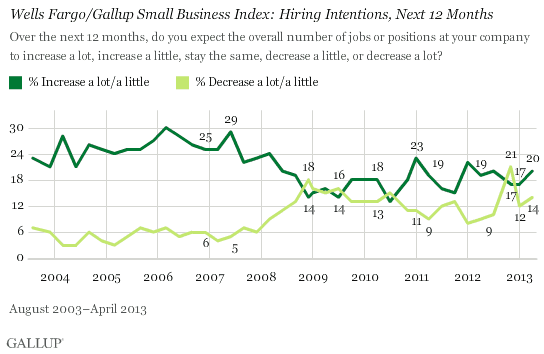PRINCETON, NJ -- More U.S. small-business owners report letting employees go than hiring them on average over the past year, for a net hiring index of -12 in April, according to the Wells Fargo/Gallup Small Business Index survey. This is on par with -10 in January and -9 in April 2012.

These results are from the quarterly Wells Fargo/Gallup Small Business survey, conducted April 1-5, 2013, with a random sample of 603 small-business owners.
Small-business owners' self-reported net hiring has remained at a similar level since January 2011, but is up from the low of -27 recorded in January 2010.
The 11% of small-business owners who reported a net jobs increase at their companies over the past 12 months is similar to the percentage who reported this in January and last April; the same is true for the 23% reporting a decrease in the number of job positions.

Owners' Hiring Intentions Flat in April
U.S. small-business owners' net hiring intentions were at +6 in April, as the percentage of owners who expect to add net new jobs is slightly more than the percentage who plan to eliminate them over the next 12 months. The April reading is about the same as the +5 of January, but slightly below the +10 of April 2012. Net hiring expectations were at -4 in November 2012, immediately after the presidential election.

Net hiring intentions are calculated by subtracting the percentage of owners expecting a decrease in jobs from the percentage expecting an increase. Currently, 20% of small-business owners say they expect to increase the number of jobs at their companies, up slightly from 17% in January and about the same as the 19% from April 2012. At the same time, 14% of owners say they expect the number of jobs or positions at their companies to decrease over the next 12 months, about the same as the 12% of January 2013, but up from the 9% who held such expectations in April 2012.

Implications
Despite the surge on Wall Street and Americans' increasing confidence in the economy on Main Street this year, small-business-owners' self-reported net hiring over the past 12 months remains anemic. While owners' net hiring intentions for the next 12 months remain slightly positive, they trail where they were at this time last year.
It may be argued that since early April, when this small-business survey was conducted, owner optimism has improved. That is, small-business owners could be more optimistic now than they were when they expressed slight optimism in this survey.
At the same time, four in 10 small-business owners say they have held back on hiring, and one in five owners say they have let employees go, due to the healthcare costs associated with the Affordable Care Act. As implementation of the law continues, the number of small-business owners who take these steps could increase.
Further, Gallup's Payroll to Population (P2P) measure is no better at the end of the third week of May than it was in May 2012. In turn, the lack of improvement in this overall job measure suggests that many small businesses -- the key drivers of job growth -- are not doing a lot of hiring of full-time employees, consistent with their April hiring intentions.
At this point, there seems to be a lot of optimism on both Wall Street and Main Street. However, it has not translated into significantly increased small-business job growth. Because small businesses are the key driver of job growth in the U.S. economy, it is hard to see how the recent surge in economic optimism -- at least on Main Street -- can continue to increase without increased small-business job growth.
About the Wells-Fargo Small Business Index
Since August 2003, the Wells Fargo/Gallup Small Business Index has surveyed small-business owners on current and future perceptions of their business financial situations.
Survey Methods
Results for the total dataset are based on telephone interviews with 603 small-business owners, conducted April 1-5, 2013. For results based on the total sample of small-business owners, one can say with 95% confidence that the maximum margin of sampling error is ±4 percentage points.
Sampling is done on a random-digit-dial basis using Dun & Bradstreet sampling of small businesses having $20 million or less of sales or revenues. The data are weighted to be representative of U.S. small businesses within this size range nationwide.
In addition to sampling error, question wording and practical difficulties in conducting surveys can introduce error or bias into the findings of public opinion polls.
For more details on Gallup's polling methodology, visit www.gallup.com.
